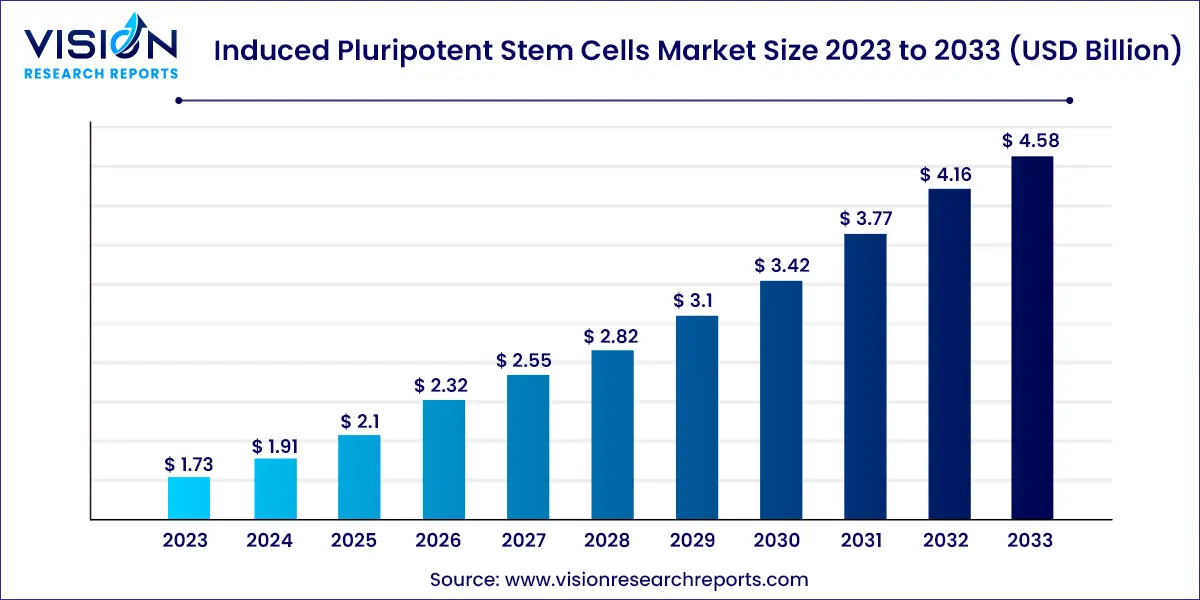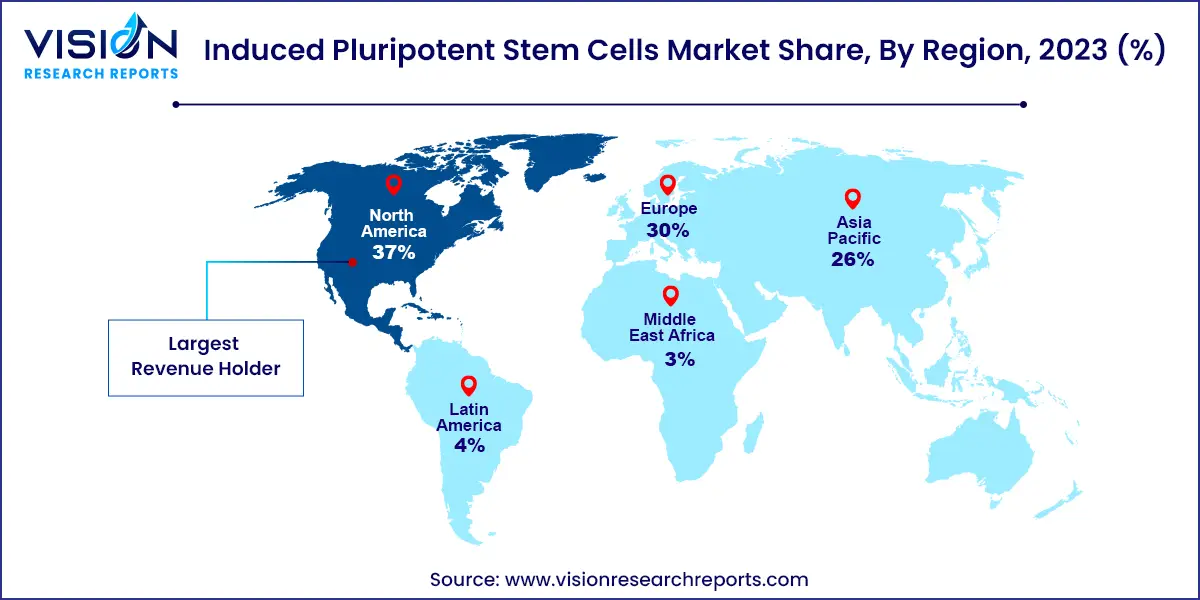The global induced pluripotent stem cells market size was estimated at around USD 1.73 billion in 2023 and it is projected to hit around USD 4.58 billion by 2033, growing at a CAGR of 10.23% from 2024 to 2033. Induced pluripotent stem cells (iPSCs) have revolutionized the field of regenerative medicine and research by providing a versatile and ethical alternative to embryonic stem cells. Derived from adult somatic cells through genetic reprogramming, iPSCs exhibit pluripotency, meaning they can differentiate into almost any cell type in the body. This capability makes iPSCs highly valuable for various applications, including disease modeling, drug discovery, and cell therapy.

The growth of the induced pluripotent stem cells (iPSCs) market is propelled by an advancement in reprogramming technologies and culture methodologies have significantly improved the efficiency and safety of iPSC production. Innovations such as the development of non-integrative reprogramming methods and optimized culture conditions have made iPSCs more accessible and reliable for research and therapeutic applications. Additionally, the expanding scope of iPSC applications—ranging from disease modeling and drug screening to personalized medicine and regenerative treatments—is driving market expansion. The increasing prevalence of chronic and genetic diseases underscores the need for effective therapies and personalized treatment solutions, further fueling interest in iPSC-based approaches. Moreover, substantial investments in stem cell research from both public and private sectors, along with supportive regulatory frameworks, are enhancing the overall growth trajectory of the iPSC market.
North America led the market with a 37% share in 2023, driven by a robust research infrastructure and substantial public and private funding for biotechnology and healthcare. The region’s strong support for stem cell research and therapies contributes significantly to its market dominance.
| Attribute | North America |
| Market Value | USD 0.64 Billion |
| Growth Rate | 10.25% CAGR |
| Projected Value | USD 1.69 Billion |
In Europe, the iPSC market is growing due to robust R&D activities in biology, pharmaceuticals, and therapeutics, coupled with the presence of key market players. This growth reflects Europe's strong emphasis on research and development.

In Asia Pacific, the iPSC market is expected to grow at the fastest CAGR of 12.34% from 2024 to 2033. This rapid growth is attributed to increased government support for the healthcare sector and rising awareness of cell therapies and personalized medicine.
In 2023, fibroblasts led the market with a dominant share of 31%. These cells, being the most accessible in the skin, are increasingly pivotal in cell therapy due to their regenerative capabilities. Dermal fibroblasts are crucial for synthesizing extracellular matrix components like glycosaminoglycans and collagens, which maintain the skin's structural integrity. Preclinical studies have demonstrated the effectiveness of allogeneic and autologous dermal fibroblasts in treating burn ulcers, wound healing, and genetic skin disorders. The potential of iPSCs derived from fibroblasts and gene-edited fibroblasts as treatments for skin issues is driving significant market growth.
The hepatocytes segment is projected to experience the highest growth rate, with a CAGR of 12.93% from 2024 to 2033. This growth is attributed to the rising incidence of liver disorders, sedentary lifestyles, and increased alcohol consumption. According to the National Institutes of Health (NIH), liver disease was responsible for one in every 25 deaths globally in March 2023, equating to two million deaths annually and accounting for 4% of all deaths, with men representing nearly two-thirds of these fatalities.
In 2023, the drug development segment captured the largest market share of 50%. The World Health Organization (WHO) reports that non-communicable diseases, including cardiovascular disorders, cancer, chronic respiratory diseases, and diabetes, claim 41 million lives annually. This high prevalence underscores the need for extensive disease research. iPSCs are instrumental in disease modeling, facilitating the discovery and development of new treatments. For instance, Evotec SE has established an iPSC infrastructure to support efficient and reproducible drug screening.
The tissue engineering and regenerative medicine segment is anticipated to grow at the fastest rate, with a CAGR of 11.93% from 2024 to 2033. Although iPSC applications for tissue development are still emerging, their potential to generate any cell or tissue type makes them crucial for treating conditions such as spinal cord injuries, leukemia, and heart disease. These cells can also be used to create genetically matched, rejection-proof tissues for transplantation, thereby advancing the market.
The pharmaceutical and biotechnology companies segment held the largest market share of 60% in 2023. These companies are investing heavily in developing stem cell-based therapies to leverage the commercial potential of iPSCs. For example, Fate Therapeutics announced in October 2022 that it would present preclinical and clinical results from various iPSC product platforms at the Society for Immunotherapy of Cancer (SITC) meeting in November 2022, highlighting a robust iPSC product pipeline and supporting market growth.
The academic and research institutes segment is expected to grow at the fastest rate, with a CAGR of 10.94% over the forecast period. iPSCs are increasingly used in academic and clinical research due to their therapeutic potential. For instance, the University of Minnesota expanded its clinical trials in August 2020 to explore engineered iPSC-derived natural killer cells for treating COVID-19. Additionally, Indiana University researchers began a study in March 2022 to investigate the use of human iPSCs to restore vision in diabetic patients. The growing research environment for evaluating iPSC-based treatments is likely to drive further market expansion.
By Derived Cell Type
By Application
By End-use
By Region
 Cross-segment Market Size and Analysis for
Mentioned Segments
Cross-segment Market Size and Analysis for
Mentioned Segments
 Additional Company Profiles (Upto 5 With No Cost)
Additional Company Profiles (Upto 5 With No Cost)
 Additional Countries (Apart From Mentioned Countries)
Additional Countries (Apart From Mentioned Countries)
 Country/Region-specific Report
Country/Region-specific Report
 Go To Market Strategy
Go To Market Strategy
 Region Specific Market Dynamics
Region Specific Market Dynamics Region Level Market Share
Region Level Market Share Import Export Analysis
Import Export Analysis Production Analysis
Production Analysis Others
Others